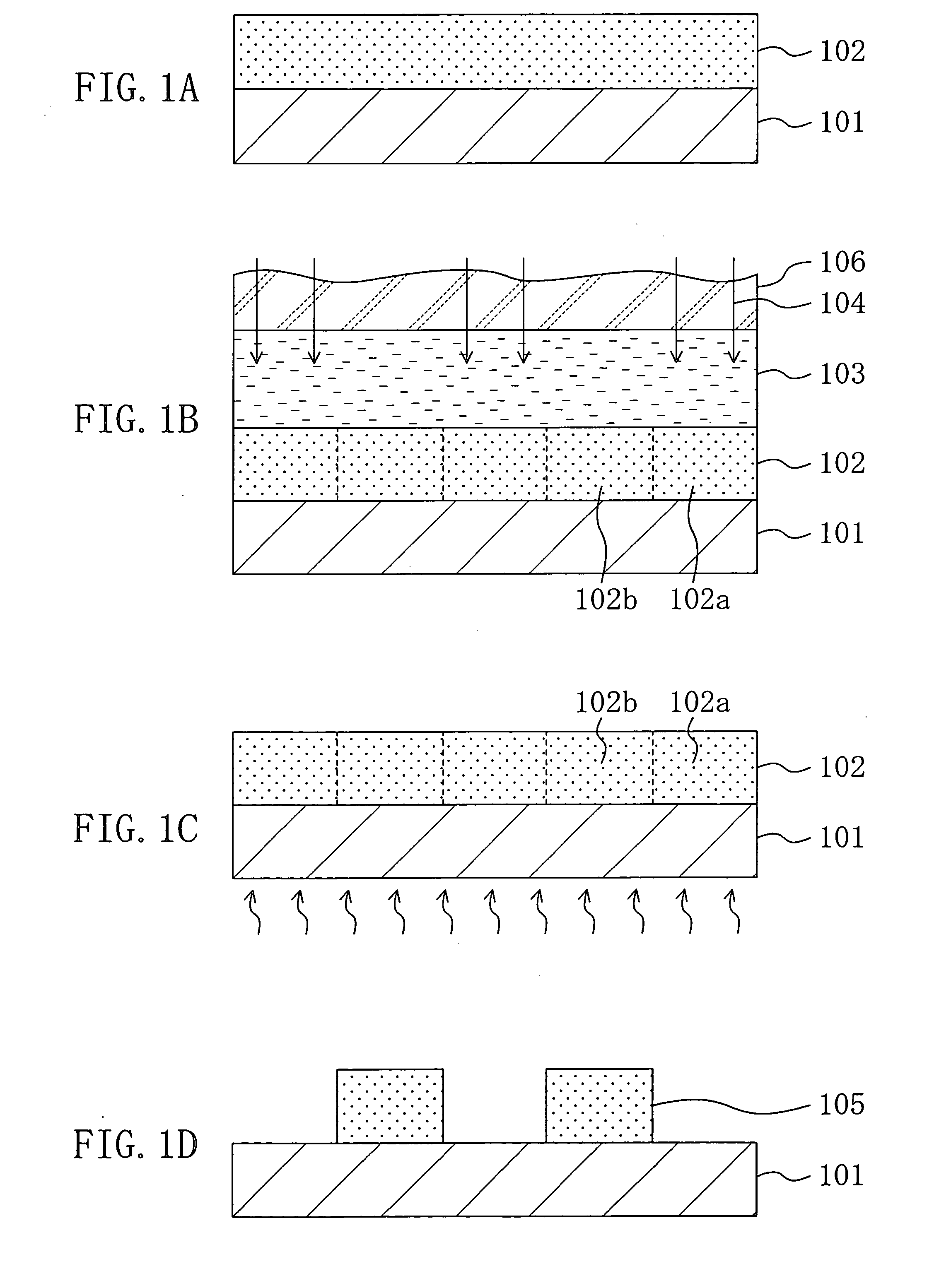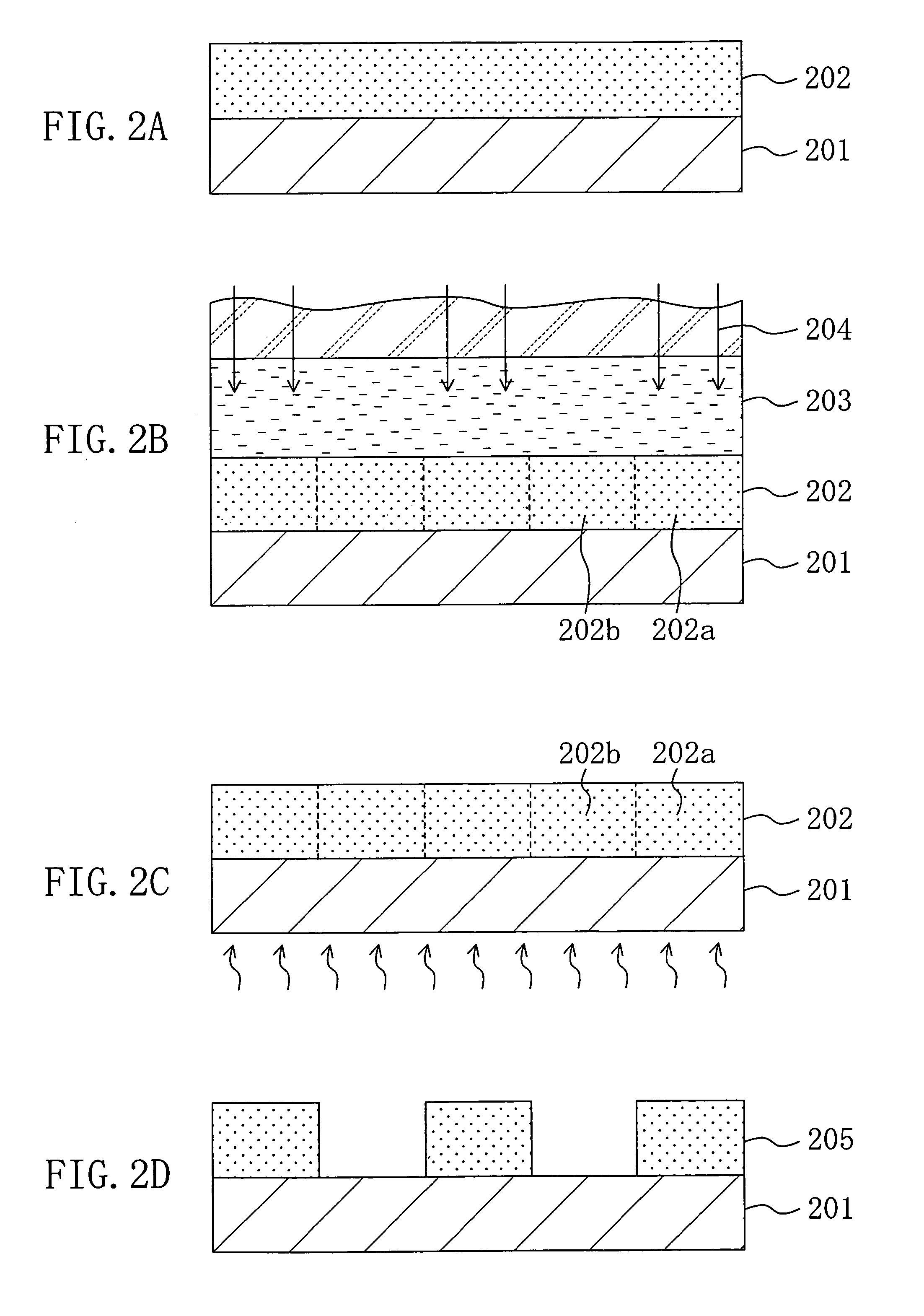Pattern formation method
a pattern and pattern technology, applied in the field of pattern formation methods, can solve the problems of reducing the productivity and yield of the semiconductor device fabrication process, the shape of the resist pattern, and the inability to use photolithography using a shorter wavelength. the effect of neutralization
- Summary
- Abstract
- Description
- Claims
- Application Information
AI Technical Summary
Benefits of technology
Problems solved by technology
Method used
Image
Examples
embodiment 1
[0052]A pattern formation method according to Embodiment 1 of the invention will now be described with reference to FIGS. 1A through 1D.
[0053]First, a positive chemically amplified resist material having the following composition is prepared:
[0054]Base polymer: poly((styrenehexafluoroisopropylalcohol)-(α-trifluoromethyl t-butylacrylate)) (wherein styrenehexafluoroisopropylalcohol: α-trifluoromethyl t-butylacrylate=40 mol %:60 mol %) . . . 2 g
[0055]Acid generator: triphenylsulfonium triflate . . . 0.08 g
[0056]Solvent: propylene glycol monomethyl ether acetate . . . 20 g
[0057]Next, as shown in FIG. 1A, the aforementioned chemically amplified resist material is applied on a substrate 101 so as to form a resist film 102 with a thickness of 0.35 μm.
[0058]Then, as shown in FIG. 1B, while supplying, onto the resist film 102, a solution 103 of water including 0.01 wt % of triethanolamine (a basic compound), pattern exposure is carried out by irradiating the resist film 102 with exposing lig...
embodiment 2
[0061]A pattern formation method according to Embodiment 2 of the invention will now be described with reference to FIGS. 2A through 2D.
[0062]First, a negative chemically amplified resist material having the following composition is prepared:
[0063]Base polymer: poly((styrenehexafluoroisopropylalcohol)-(α-trifluoromethylacrylic acid)) (wherein styenehexafluoroisopropyalchol: α-trifluoromethylacrylic acid=40 mol %:60 mol %) . . . 2 g
[0064]Crosslinking agent: 1,3,5-N-(dimethoxymethyl)melamine . . . 0.7 g
[0065]Acid generator: triphenylsulfonium triflate . . . 0.08 g
[0066]Solvent: propylene glycol monomethyl ether acetate . . . 20 g
[0067]Next, as shown in FIG. 2A, the aforementioned chemically amplified resist material is applied on a substrate 201 so as to form a resist film 202 with a thickness of 0.35 μm.
[0068]Then, as shown in FIG. 2B, while supplying, onto the resist film 202, a solution 203 of water including 0.02 wt % of trimethylamine (a basic compound), pattern exposure is carri...
embodiment 3
[0088]A pattern formation method according to Embodiment 3 of the invention will now be described with reference to FIGS. 3A through 3D.
[0089]First, a positive chemically amplified resist material having the following composition is prepared:
[0090]Base polymer: poly((styrenehexafluoroisopropylalcohol)-(α-trifluoromethyl t-butylacrylate)) (wherein styrenehexafluoroisopropylalcohol: α-trifluoromethyl t-butylacrylate=40 mol %:60 mol %) . . . 2 g
[0091]Acid generator: triphenylsulfonium triflate . . . 0.08 g
[0092]Solvent: propylene glycol monomethyl ether acetate . . . 20 g
[0093]Next, as shown in FIG. 3A, the aforementioned chemically amplified resist material is applied on a substrate 301 so as to form a resist film 302 with a thickness of 0.20 μm.
[0094]Then, as shown in FIG. 3B, while supplying, onto the resist film 302, a solution 303 of perfluoropolyether (represented by Chemical Formula 1 below) including 0.02 wt % of polyvinylamine (a basic polymer), pattern exposure is carried out...
PUM
| Property | Measurement | Unit |
|---|---|---|
| mol % | aaaaa | aaaaa |
| thickness | aaaaa | aaaaa |
| temperature | aaaaa | aaaaa |
Abstract
Description
Claims
Application Information
 Login to View More
Login to View More - R&D
- Intellectual Property
- Life Sciences
- Materials
- Tech Scout
- Unparalleled Data Quality
- Higher Quality Content
- 60% Fewer Hallucinations
Browse by: Latest US Patents, China's latest patents, Technical Efficacy Thesaurus, Application Domain, Technology Topic, Popular Technical Reports.
© 2025 PatSnap. All rights reserved.Legal|Privacy policy|Modern Slavery Act Transparency Statement|Sitemap|About US| Contact US: help@patsnap.com



